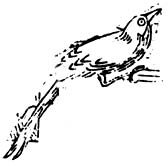|
 tatkasmaddhetoh/
tatkasmaddhetoh/
(cont. from issue #114)
by Bhikshuni Heng Hsien
"Why 1s that?"
After describing how the hamsah
"geese," krauncah "curlews,"
and mayurah
"peacocks"
chant the Buddhadharma
in Sukhavatt, Sakyamuni Buddha asked his disciple
Sariputra if
he thought the birds were
tiryagyonigatah, born as animals
because of karmic retribution.
Before Sariputra could
answer, the Buddha said: Na punar
evam drastavyam,
"It shouldn't
be
seen that way."
Now the Buddha asks: tatkasmaddhetoh,
"Why is that?"
tat
is the nominative
neuter singular
of the demonstrative pronoun "this/that." In
the Sanskrit writing system,
the final -t is joined to the initial k-
of kasmad,
but
they are separate
words.
kasmat is the ab1ative
singular
masculine of the interrogative
pronoun "who/what?"
Here it is written kasmad,
final
unvoiced -t
changing to voiced -d
before the initial h- of
hetoh. The
initial h-
of hetoh
is in turn influenced
to become dh-, and for economy in
writing, the two words are also joined
in the script.
hetoh is the ablative
singular
of the masculine
noun hetu "cause/reason." The
ablative
case here
expresses cause or origin, and so kasmad-d-hetoh
means "for what
reason?" and tad kasmad-d-hetoh
literally asks, "This to
what reason?" That
is, why
shouldn't
we consider the birds in the Land of Happiness beings
that have fallen
into the
destiny of animals,
one of the three evil destinies?
- to be continued
|
